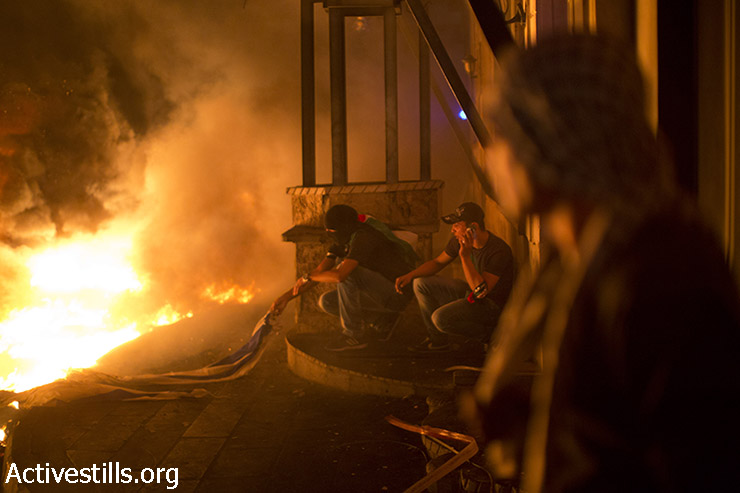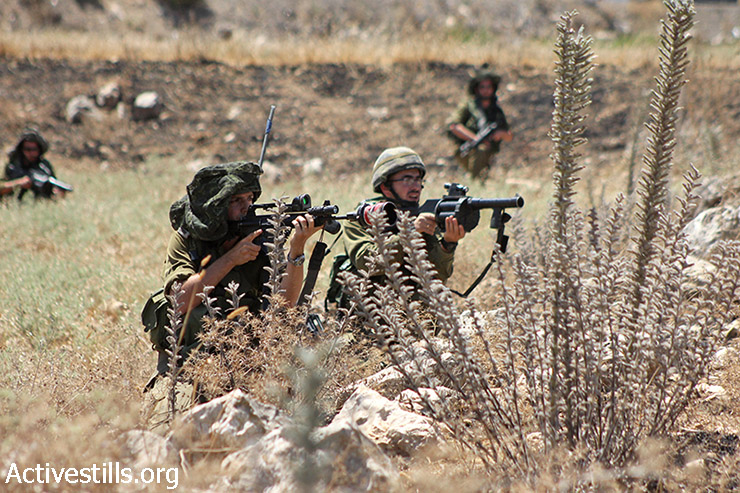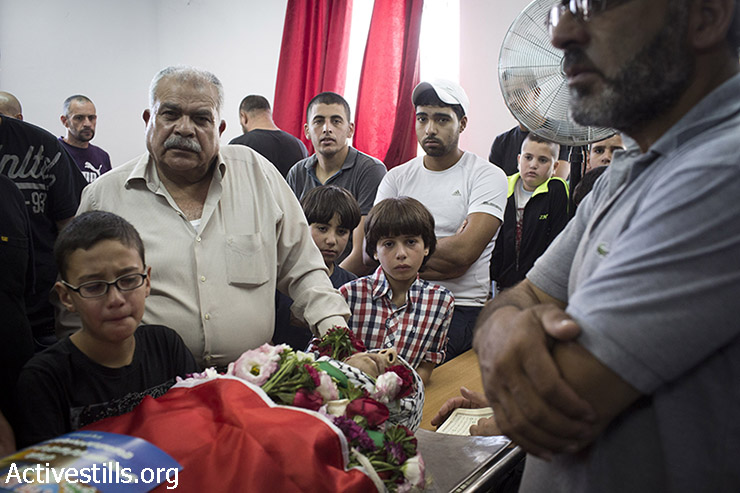Media and politicians have been quick to claim that Palestinian protests against Operation Protective Edge mark the beginning of a third intifada. But in Beit Sahour, the town that was the heart of the First Intifada, some are skeptical that today’s demonstrations will turn into tomorrow’s revolution.
Some ten thousand Palestinians marched from Ramallah on Thursday night to Qalandia checkpoint, in protest of Israel’s military assault on the Gaza Strip and in hopes of reaching Jerusalem. One man was killed and dozens were injured in what was the largest demonstration the West Bank has seen in years.
While protesters and observers alike speculate that this marks the beginning of the Third Intifada, the mood in Beit Sahour – the small, predominately Christian town that was the heart of the First Intifada – is decidedly more pessimistic.
Speaking on the condition of anonymity, “Nasser,” a Beit Sahouri and veteran of the First Intifada who was arrested nearly a dozen times for his political activities says that recent protests in West Bank are “emotional.”

Palestnians marched from Al Amar refugee camp to Qalandyia checkpoint to protest against the Israeli attack on Gaza. (Oren Ziv/Activestills.org)
The First Intifada was “based on hope,” he explains, which allowed people to slow down, think ahead, and “restrain themselves and strategize.”
People are “moving out of emotions now and that becomes violent,” Nasser says, pointing to the Second Intifada as an example. Many Palestinians feel that the Second Intifada accomplished very little.
Today, he adds, “We lack any political movement that’s capable of moving the masses—neither Hamas, nor Fatah, nor any other group.”
Nasser’s sentiments were echoed at a small demonstration in Beit Sahour on Monday, as the West Bank observed a general strike in protest of Operation Protective Edge and what is being called a massacre in Shajaiyah. A few dozen protesters attempted to march towards an Israeli army base that is perched on a hill outside the village. But they were quickly deterred by tear gas.
“This is all about Gaza right now,” said a woman in her late twenties. She hung back, watching, as the shebab, young men, edged forward. “When there’s a ceasefire, the people [in the West Bank] will go back to sleep.”
For years, Palestinians have pointed out that demonstrations in the West Bank are usually reactionary and don’t reflect clear goals, vision, or a long-term strategy. Protests and strikes against Israel’s last two military operations in Gaza – 2008-2009’s Operation Cast Lead and 2012’s Operation Pillar of Defense – did not snowball into Intifadas.
“We have no leadership,” is another oft-repeated explanation as to why there is no sustained revolt against the Israeli occupation. Palestinian Authority President Mahmoud Abbas is widely viewed as a puppet who is more concerned with placating the Israelis than taking care of his people. And West Bank protests are often put down by Palestinian Authority security forces.
Click here for +972′s full coverage of the war in Gaza
A professional in his mid-30s, who was born and raised in Beit Sahour and whose father was arrested three times during the First Intifada, attended Monday night’s march. The man, who asked to be identified by a pseudonym, felt discouraged by the small demonstration. “There’s no one supporting the protesters,” George said, calling the PA the “Palestinian Zionist Authority.”
“When you have an authority that supposedly works for your benefit and you see the [Palestinian] security personnel…acting just like Israeli soldiers,” George continued. “There will be no motivation to do anything.”
Dr. Mazin Qumsiyeh is the author of Popular Resistance in Palestine, a professor at Bethlehem University, and an activist. He responds to concerns regarding leadership and organization.
Such questions, Dr. Qumsiyeh says, “assume that colonized, occupied people sit down together to come up with a strategy. If you’re looking for organization, it doesn’t happen this way. Sometimes at the peak of a revolution, leaders emerge—revolution makes leaders, leaders don’t make revolutions.”

He adds that claims that leaders or political parties are necessary for an intifada suggest that Palestinians are “still thinking paternalistically, that a father figure has to tell them what to do.”
Dr. Qumsiyeh points to the spontaneous nightly protests in Bethlehem as proof positive that the youth can get an intifada moving on their own. “Uprisings happen when there is no leadership. That’s happening in Bethlehem now. Who told these kids to go out every night?”
Hundreds of protesters have attend the nightly demonstrations in Bethlehem, which neighbors Beit Sahour. But these demonstrations are dominated by shebab – young Palestinian men. And some young Palestinian women say they’re uncomfortable joining.
“We are a patriarchal society,” Dr. Qumsiyeh reflects. “I hate that personally. The old men in the PLO—I’d love to see them all gone and see women and young people in charge.”
While the media’s eyes are trained on the male-dominated, urban protests that erupted in response to Operation Protective Edge, demonstrations are more sustained and egalitarian in the Palestinian villages. The weekly protest in Nabi Saleh comes to mind. Since 2009, men, women, and children have been marching to reach the village’s spring that was expropriated by Israel. Nariman Tamimi, the wife of organizer Bassem Tamimi, is a leader in the demonstrations. And Nabi Saleh has seen a number of women’s marches, as well.
Indeed, many argue that the strength of the First Intifada is that it engaged men, women, children, and families of all economic classes. That the middle class Beit Sahouris interviewed for this article all asked to remain anonymous suggests that, today, they feel like they have too much to lose.
Many here say that neoliberal policies has had a sedating effect on the West Bank. Some blame former Prime Minister Salam Fayyad and his focus on economic development; they blame banks that give loans to Palestinians, encouraging them to live beyond their means and chaining them to debt. Others point to a society that is increasingly driven by consumerism.

All people think about today, George argues, “is paying off their debt. There’s no time to think of the occupation.” He adds that in 1987, when the First Intifada began, the financial system was different. Loans and consumerism “didn’t exist” then.
Nasser agrees that Palestinian society is more consumerist and individualistic than it was in the past and that this is an obstacle to getting a revolution off the ground. But he’s quick to add that “the generation that grew up under the PA and Israel cannot help but be individualistic, to find a way to benefit from the situation.”
Also problematic, Nasser says, is that Palestinians have “adapted” to the occupation. “We got used to not going to Jerusalem, we got used to checkpoints. We’ve lost a major part of our self-respect. We cannot have a massive intifada without a mental shift.”
While Dr. Qumsiyeh agrees, remarking, “Our first liberation has to be of our own minds,” he insists that the circumstances are ripe for a revolution. He ticks the list off on his hand, taking the opportunity to again point out that previous intifadas didn’t begin with leaders but, rather, with the people.
“They started because of pent-up frustration,” he says. The other conditions? “One: paralysis of the peace process; two: lack of trust in the Palestinian leadership.” The third, according to Dr. Qumsiyeh, is that “the occupier becomes even more arrogant. They assume they can get away with anything.”
Like killing civilians in Gaza.
Nasser maintains that the Third Intifada has yet to begin. But he calls it “inevitable.”
“There’s one thing I’m sure of,” he says. “Palestinians are not going to raise a white flag.”
As for the young woman who, on Monday, was sure that the West Bank will go back to sleep – on Friday morning, she woke up to the news of the 10,000 strong march on Qalandiya. And she said, “[No one] can predict anything anymore.”
A shorter version of this article was first published on Al Jazeera English.
Related:
‘The largest West Bank protest in decades’
PHOTOS: Ten killed across West Bank in Gaza solidarity protests
Israel has alternatives to this war

